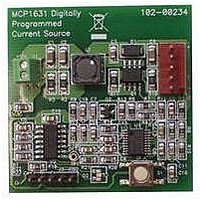MCP1631RD-MCC1 Microchip Technology, MCP1631RD-MCC1 Datasheet - Page 222

MCP1631RD-MCC1
Manufacturer Part Number
MCP1631RD-MCC1
Description
REFERENCE DESIGN FOR MCP1631HV
Manufacturer
Microchip Technology
Type
Battery Managementr
Datasheets
1.MCP1631VHVT-330EST.pdf
(34 pages)
2.MCP1631HV-330EST.pdf
(54 pages)
3.MCP1631RD-MCC2.pdf
(20 pages)
4.MCP1631RD-MCC2.pdf
(328 pages)
5.MCP1631RD-MCC1.pdf
(28 pages)
Specifications of MCP1631RD-MCC1
Main Purpose
Power Management, Battery Charger
Embedded
Yes, MCU, 8-Bit
Utilized Ic / Part
MCP1631HV, PIC16F883
Primary Attributes
1 ~ 2 Cell- Li-Ion, 1 ~ 4 Cell- NiCd/NiMH
Secondary Attributes
Status LEDs
Supported Devices
MCP1631HV, PIC16F883 Device Type
Tool / Board Applications
Power Management-Battery Management
Development Tool Type
Reference Design
Input Voltage
5.5 V to 16 V
Product
Power Management Modules
Mcu Supported Families
MCP1631HV/PIC16F883 Family
Silicon Manufacturer
Microchip
Silicon Core Number
MCP1631HV
Kit Application Type
Reference Design
Application Sub Type
Battery Charger
Kit Contents
Board Only
Lead Free Status / RoHS Status
Lead free / RoHS Compliant
For Use With/related Products
MCP1631HV, PIC16F883
Lead Free Status / RoHS Status
Lead free / RoHS Compliant
- MCP1631VHVT-330EST PDF datasheet
- MCP1631HV-330EST PDF datasheet #2
- MCP1631RD-MCC2 PDF datasheet #3
- MCP1631RD-MCC2 PDF datasheet #4
- MCP1631RD-MCC1 PDF datasheet #5
- Current page: 222 of 328
- Download datasheet (6Mb)
PIC16F882/883/884/886/887
14.3
The
interrupt sources:
• External Interrupt RB0/INT
• Timer0 Overflow Interrupt
• PORTB Change Interrupts
• 2 Comparator Interrupts
• A/D Interrupt
• Timer1 Overflow Interrupt
• Timer2 Match Interrupt
• EEPROM Data Write Interrupt
• Fail-Safe Clock Monitor Interrupt
• Enhanced CCP Interrupt
• EUSART Receive and Transmit Interrupts
• Ultra Low-Power Wake-up Interrupt
• MSSP Interrupt
The Interrupt Control register (INTCON) and Peripheral
Interrupt Request Register 1 (PIR1) record individual
interrupt requests in flag bits. The INTCON register
also has individual and global interrupt enable bits.
A Global Interrupt Enable bit, GIE (INTCON<7>),
enables (if set) all unmasked interrupts, or disables (if
cleared) all interrupts. Individual interrupts can be
disabled through their corresponding enable bits in the
INTCON, PIE1 and PIE2 registers, respectively. GIE is
cleared on Reset.
The Return from Interrupt instruction, RETFIE, exits
the interrupt routine, as well as sets the GIE bit, which
re-enables unmasked interrupts.
The following interrupt flags are contained in the INT-
CON register:
• INT Pin Interrupt
• PORTB Change Interrupts
• Timer0 Overflow Interrupt
The peripheral interrupt flags are contained in the PIR1
and PIR2 registers. The corresponding interrupt enable
bits are contained in PIE1 and PIE2 registers.
The following interrupt flags are contained in the PIR1
register:
• A/D Interrupt
• EUSART Receive and Transmit Interrupts
• Timer1 Overflow Interrupt
• Synchronous Serial Port (SSP) Interrupt
• Enhanced CCP1 Interrupt
• Timer1 Overflow Interrupt
• Timer2 Match Interrupt
DS41291F-page 220
PIC16F882/883/884/886/887
Interrupts
has
multiple
The following interrupt flags are contained in the PIR2
register:
• Fail-Safe Clock Monitor Interrupt
• 2 Comparator Interrupts
• EEPROM Data Write Interrupt
• Ultra Low-Power Wake-up Interrupt
• CCP2 Interrupt
When an interrupt is serviced:
• The GIE is cleared to disable any further interrupt.
• The return address is pushed onto the stack.
• The PC is loaded with 0004h.
For external interrupt events, such as the INT pin,
PORTB change interrupts, the interrupt latency will be
three or four instruction cycles. The exact latency
depends upon when the interrupt event occurs (see
Figure 14-8). The latency is the same for one or
two-cycle instructions. Once in the Interrupt Service
Routine, the source(s) of the interrupt can be
determined by polling the interrupt flag bits. The
interrupt flag bit(s) must be cleared in software before
re-enabling interrupts to avoid multiple interrupt
requests.
For
comparators, A/D, data EEPROM, EUSART, MSSP or
Enhanced CCP modules, refer to the respective
peripheral section.
14.3.1
External interrupt on RB0/INT pin is edge-triggered;
either rising if the INTEDG bit (OPTION_REG<6>) is
set, or falling, if the INTEDG bit is clear. When a valid
edge appears on the RB0/INT pin, the INTF bit
(INTCON<1>) is set. This interrupt can be disabled by
clearing the INTE control bit (INTCON<4>). The INTF
bit must be cleared in software in the Interrupt Service
Routine before re-enabling this interrupt. The RB0/INT
interrupt can wake-up the processor from Sleep, if the
INTE bit was set prior to going into Sleep. The status of
the GIE bit decides whether or not the processor
branches to the interrupt vector following wake-up
(0004h). See Section 14.6 “Power-Down Mode
(Sleep)” for details on Sleep and Figure 14-10 for
timing of wake-up from Sleep through RB0/INT
interrupt.
Note 1: Individual interrupt flag bits are set,
additional
2: When an instruction that clears the GIE
RB0/INT INTERRUPT
regardless
corresponding mask bit or the GIE bit.
bit is executed, any interrupts that were
pending for execution in the next cycle
are ignored. The interrupts, which were
ignored, are still pending to be serviced
when the GIE bit is set again.
information
© 2009 Microchip Technology Inc.
of
the
on
status
Timer1,
of
Timer2,
their
Related parts for MCP1631RD-MCC1
Image
Part Number
Description
Manufacturer
Datasheet
Request
R

Part Number:
Description:
REFERENCE DESIGN MCP1631HV
Manufacturer:
Microchip Technology
Datasheet:

Part Number:
Description:
REF DES BATT CHARG OR LED DRIVER
Manufacturer:
Microchip Technology
Datasheet:

Part Number:
Description:
Manufacturer:
Microchip Technology Inc.
Datasheet:

Part Number:
Description:
Manufacturer:
Microchip Technology Inc.
Datasheet:

Part Number:
Description:
Manufacturer:
Microchip Technology Inc.
Datasheet:

Part Number:
Description:
Manufacturer:
Microchip Technology Inc.
Datasheet:

Part Number:
Description:
Manufacturer:
Microchip Technology Inc.
Datasheet:

Part Number:
Description:
Manufacturer:
Microchip Technology Inc.
Datasheet:

Part Number:
Description:
Manufacturer:
Microchip Technology Inc.
Datasheet:

Part Number:
Description:
Manufacturer:
Microchip Technology Inc.
Datasheet:










